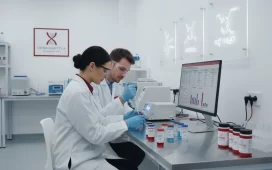It’s super important to catch brain damage early in infants because, well, the sooner you know, the sooner you can do something about it. Spotting the signs isn’t always easy, but there are a few things to watch out for. It’s not about being paranoid, but just being aware.
Unusual Muscle Tone
One thing doctors look for is unusual muscle tone. This can show up in a couple of ways. Sometimes, a baby might seem really stiff, like their muscles are always tense. Other times, they might be super floppy, almost like a rag doll. Neither of these is necessarily a sign of brain damage on its own, but it’s something to keep an eye on, especially if it’s consistent. It’s more about the extremes – consistently too stiff or too floppy – that raise a red flag. Things to consider:
- Is the baby’s movement restricted?
- Does the baby resist being held or positioned?
- Is there a noticeable difference between one side of the body and the other?
Lack of Response to Stimuli
Babies are usually pretty curious, right? They react to sounds, lights, and touch. But if a baby isn’t responding to these things like you’d expect, it could be a sign of something going on. I mean, every baby has their off days, but if they consistently don’t react to stimuli, it’s worth checking out. For example:
- Not startling at loud noises.
- Not following moving objects with their eyes.
- Showing no reaction to being touched or picked up.
Delayed Developmental Milestones
Okay, so every baby develops at their own pace, and there’s a pretty wide range of what’s considered “normal.” But if a baby is consistently behind on hitting those developmental milestones, it could be a sign of brain damage. We’re talking about things like:
- Not rolling over by six months.
- Not sitting up by nine months.
- Not babbling or making sounds by 12 months.
Again, one delayed milestone isn’t necessarily a cause for panic, but a pattern of delays should definitely be discussed with a doctor.
Behavioral Indicators of Brain Injury
Behavioral changes can be subtle but significant indicators of brain injury in infants. It’s not always obvious, but paying attention to how a baby acts can give clues about their health. Sometimes, it’s just a phase, but other times, it’s something more serious.
Excessive Irritability
One common sign is excessive irritability. A baby who is constantly fussy, cries inconsolably for extended periods, or is easily agitated might be experiencing discomfort related to a brain injury. It’s more than just a bad day; it’s a persistent pattern. This irritability often seems out of proportion to the situation. Think about it: is the baby always upset, even when they’re fed, changed, and rested?
Difficulty Feeding
Feeding difficulties can also point to potential problems. This isn’t just about being a picky eater. It’s about a real struggle to eat.
Here are some things to watch for:
- Poor sucking or swallowing
- Frequent gagging or choking
- Refusal to feed or take a bottle
- Taking a very long time to feed
These issues can stem from neurological problems affecting the muscles and coordination needed for feeding. If you notice these, it’s worth talking to a doctor.
Sleep Disturbances
Sleep patterns can also change after a brain injury. Some babies may sleep excessively, while others experience significant difficulty falling or staying asleep. Disrupted sleep cycles can be a sign that the brain isn’t regulating itself properly. It’s not just about being tired; it’s about a fundamental change in how the baby sleeps. For example, a baby who used to sleep through the night suddenly wakes up every hour, or a baby who was always active now sleeps almost all day. These changes warrant attention, especially if they occur alongside other symptoms. Remember that Shaken Baby Syndrome can manifest through various symptoms.
Physical Symptoms to Monitor
It’s important to keep an eye out for certain physical signs that could indicate a problem. Sometimes, these symptoms are subtle, but they can be significant clues about a child’s health. Paying close attention to these physical manifestations is key for early detection and intervention.
Seizures
Seizures in infants can be alarming and take different forms. They might involve convulsions, where the baby’s body stiffens and jerks. Or, they could be more subtle, like a brief staring spell or unusual movements. If a parent suspects their child is having seizures, it’s important to record the events and seek medical attention right away. Early intervention can help manage the seizures and minimize potential long-term effects. It’s also important to understand that not all seizures indicate brain damage, but they always warrant a thorough evaluation. If you suspect your child has cerebral palsy, seek medical advice.
Abnormal Eye Movements
Unusual eye movements can also be a sign of underlying issues. This could include:
- Nystagmus, which involves repetitive, uncontrolled eye movements.
- Strabismus, where the eyes don’t align properly (crossed eyes or walleye).
- Difficulty tracking objects with their eyes.
These issues can affect a child’s vision and development. A pediatric ophthalmologist can assess these problems and recommend appropriate treatment, such as glasses, vision therapy, or surgery.
Facial Asymmetry
Facial asymmetry refers to noticeable differences between the two sides of the face. This might involve:
- Uneven smile.
- Drooping of one side of the face.
- Difficulty with facial expressions on one side.
While some degree of asymmetry is normal, significant differences could indicate nerve damage or other underlying conditions. A medical professional can evaluate the cause of the asymmetry and determine the best course of action. Sometimes, it’s a temporary issue, but it’s always best to get it checked out.
Cognitive and Sensory Impairments
Poor Visual Tracking
Infants develop visual tracking skills gradually. If a baby struggles to follow moving objects with their eyes, it could be an early sign of a problem. Consistent difficulty in this area warrants further investigation. It’s not just about seeing; it’s about the brain’s ability to process what the eyes are seeing and coordinate movement. Sometimes, it’s subtle, like they can track to one side but not the other. Other times, it’s more obvious, and they just can’t seem to focus on anything that moves. It’s worth keeping an eye on, especially if there are other concerns.
Hearing Difficulties
Hearing is super important for a baby’s development. If a baby doesn’t react to sounds, or if they seem slow to startle at loud noises, it could mean they have a hearing problem. It’s not always obvious, though. Sometimes, they might react to some sounds but not others. Here are some things to watch out for:
- No reaction to your voice.
- Not turning towards sounds.
- Delayed speech development.
If you’re worried, it’s always best to get their hearing checked out by a professional. Early detection is key for helping them develop properly.
Cognitive Delays
Cognitive delays can show up in different ways. It might be that the baby isn’t reaching milestones at the expected times. For example, they might not be babbling, sitting up, or reaching for toys when other babies their age are. It’s important to remember that all babies develop at their own pace, but if there are significant delays, it’s worth talking to a doctor. Here are some things that might indicate a cognitive delay:
- Slow to learn new things.
- Difficulty with problem-solving.
- Limited social interaction.
Importance of Early Diagnosis
Impact on Long-Term Development
Early diagnosis of brain damage in infants is super important because it can really change how things go later on. The brain develops so fast in the first few years, so catching problems early means doctors can start treatments and therapies sooner. This can help minimize the long-term effects of the injury. If you wait too long, some developmental delays might become permanent, and it’s harder to catch up. It’s like, if you see a plant isn’t growing right, you want to fix it before it’s too late, right?
Role of Pediatric Assessments
Pediatric assessments are key in spotting potential brain damage. Regular check-ups with a pediatrician involve looking at a baby’s reflexes, muscle tone, and how they’re meeting developmental milestones. These assessments aren’t just about checking off boxes; they’re about getting a full picture of the baby’s health. Pediatricians are trained to notice subtle signs that might indicate a problem, and they can order more tests or refer the baby to specialists if needed. It’s a team effort to make sure everything is on track.
Benefits of Early Intervention
Early intervention programs can make a huge difference for babies with brain damage. These programs usually include:
- Physical therapy to help with movement and coordination.
- Speech therapy to assist with communication skills.
- Occupational therapy to improve daily living skills.
Starting these therapies early can help the baby learn new ways to do things and develop skills that might otherwise be affected by the brain injury. It’s all about giving them the best possible start in life. Plus, it gives parents the support and resources they need to help their child thrive.
Parental Observations and Concerns
Tracking Developmental Changes
Parents are often the first to notice subtle deviations in their infant’s development. Consistent monitoring of milestones, such as rolling over, sitting up, and babbling, is important. It’s not about being anxious, but about being informed. Keep an eye out for:
- Delays in reaching expected milestones.
- Regression of previously acquired skills.
- Asymmetrical movements or preferences for one side of the body.
Communicating with Healthcare Providers
Open and honest communication with healthcare providers is key. Parents should promptly report any concerns or observations, no matter how minor they may seem. Don’t hesitate to bring up anything that feels “off” during routine check-ups. Remember, doctors can only help if they have all the information. Be prepared to discuss:
- Specific symptoms and when they were first noticed.
- Any changes in the infant’s behavior or physical abilities.
- Family history of neurological or developmental conditions.
Documenting Symptoms
Keeping a detailed record of symptoms can be incredibly helpful for healthcare professionals. This documentation can provide a clearer picture of the infant’s condition over time. Consider including:
- Dates and times of symptom occurrence.
- Descriptions of the symptoms (e.g., type of movement, duration of crying).
- Any factors that seem to trigger or alleviate the symptoms.
Next Steps After Identifying Symptoms
So, you’ve noticed some things and you’re worried about infant brain damage symptoms. What happens next? It’s a stressful time, but there are clear steps to take. Don’t panic; knowledge is power, and action is key.
Seeking Professional Evaluation
First things first: get a professional opinion. Schedule an appointment with a pediatrician or a pediatric neurologist. Don’t rely on Dr. Google or random internet forums. A real doctor can assess the situation properly. Be prepared to share all your observations, even the small stuff. They’ll likely conduct a thorough neurological exam and may order imaging tests like an MRI or CT scan. It’s scary, but these tests can provide vital information. Remember to bring any notes or videos you’ve taken of the symptoms. The more information you can provide, the better.
Understanding Treatment Options
Okay, you’ve got a diagnosis. Now what? Treatment options vary widely depending on the type and severity of the brain damage. There’s no one-size-fits-all approach. It could involve:
- Physical therapy to improve motor skills.
- Occupational therapy to help with daily living activities.
- Speech therapy to address communication issues.
- Medications to manage seizures or other symptoms.
- In some cases, surgery might be necessary.
Don’t be afraid to ask questions. Lots of them. Understand the risks and benefits of each treatment. Get a second opinion if you’re not comfortable with the initial recommendations. It’s your right to be fully informed.
Accessing Support Services
Dealing with infant brain damage is tough, not just on the child, but on the whole family. You don’t have to go it alone. There are tons of support services available. Look into:
- Support groups for parents of children with brain injuries. Sharing experiences with others who understand can be incredibly helpful.
- Financial assistance programs to help cover medical expenses.
- Respite care services to give you a break from caregiving.
- Educational resources to learn more about brain damage and how to best support your child.
Remember, taking care of yourself is just as important as taking care of your child. Don’t hesitate to reach out for help when you need it. It’s a marathon, not a sprint.














